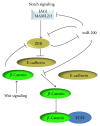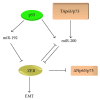The Regulatory Role of MicroRNAs in EMT and Cancer
- PMID: 25883654
- PMCID: PMC4389820
- DOI: 10.1155/2015/865816
The Regulatory Role of MicroRNAs in EMT and Cancer
Abstract
The epithelial to mesenchymal transition (EMT) is a powerful process in tumor invasion, metastasis, and tumorigenesis and describes the molecular reprogramming and phenotypic changes that are characterized by a transition from polarized immotile epithelial cells to motile mesenchymal cells. It is now well known that miRNAs are important regulators of malignant transformation and metastasis. The aberrant expression of the miR-200 family in cancer and its involvement in the initiation and progression of malignant transformation has been well demonstrated. The metastasis suppressive role of the miR-200 members is strongly associated with a pathologic EMT. This review describes the most recent advances regarding the influence of miRNAs in EMT and the control they exert in major signaling pathways in various cancers. The ability of the autocrine TGF-β/ZEB/miR-200 signaling regulatory network to control cell plasticity between the epithelial and mesenchymal state is further discussed. Various miRNAs are reported to directly target EMT transcription factors and components of the cell architecture, as well as miRNAs that are able to reverse the EMT process by targeting the Notch and Wnt signaling pathways. The link between cancer stem cells and EMT is also reported and the most recent developments regarding clinical trials that are currently using anti-miRNA constructs are further discussed.
Figures




References
-
- Bolender D. L., Markwald R. R. Epithelial-mesenchymal transformation in chick atrioventricular cushion morphogenesis. Scanning Electron Microscopy. 1979;3:313–321. - PubMed
-
- Griffith C. M., Hay E. D. Epithelial-mesenchymal transformation during palatal fusion: carboxyfluorescein traces cells at light and electron microscopic levels. Development. 1992;116(4):1087–1099. - PubMed
Publication types
LinkOut - more resources
Full Text Sources
Other Literature Sources

